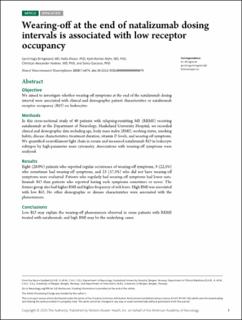| dc.contributor.author | Bringeland, Gerd Haga | |
| dc.contributor.author | Blaser, Nello | |
| dc.contributor.author | Myhr, Kjell-Morten | |
| dc.contributor.author | Vedeler, Christian A. | |
| dc.contributor.author | Gavasso, Sonia | |
| dc.date.accessioned | 2021-04-20T10:13:14Z | |
| dc.date.available | 2021-04-20T10:13:14Z | |
| dc.date.created | 2021-01-20T13:13:43Z | |
| dc.date.issued | 2020-02 | |
| dc.identifier.issn | 2332-7812 | |
| dc.identifier.uri | https://hdl.handle.net/11250/2738599 | |
| dc.description.abstract | Objective: We aimed to investigate whether wearing-off symptoms at the end of the natalizumab dosing interval were associated with clinical and demographic patient characteristics or natalizumab receptor occupancy (RO) on leukocytes.
Methods: In this cross-sectional study of 40 patients with relapsing-remitting MS (RRMS) receiving natalizumab at the Department of Neurology, Haukeland University Hospital, we recorded clinical and demographic data including age, body mass index (BMI), working status, smoking habits, disease characteristics, treatment duration, vitamin D levels, and wearing-off symptoms. We quantified neurofilament light chain in serum and measured natalizumab RO in leukocyte subtypes by high-parameter mass cytometry. Associations with wearing-off symptoms were analyzed.
Results: Eight (20.0%) patients who reported regular occurrence of wearing-off symptoms, 9 (22.5%) who sometimes had wearing-off symptoms, and 23 (57.5%) who did not have wearing-off symptoms were evaluated. Patients who regularly had wearing-off symptoms had lower natalizumab RO than patients who reported having such symptoms sometimes or never. The former group also had higher BMI and higher frequency of sick leave. High BMI was associated with low RO. No other demographic or disease characteristics were associated with the phenomenon.
Conclusions: Low RO may explain the wearing-off phenomenon observed in some patients with RRMS treated with natalizumab, and high BMI may be the underlying cause. | en_US |
| dc.language.iso | eng | en_US |
| dc.publisher | Wolters Kluwer Health | en_US |
| dc.rights | Navngivelse 4.0 Internasjonal | * |
| dc.rights.uri | http://creativecommons.org/licenses/by/4.0/deed.no | * |
| dc.title | Wearing-off at the end of natalizumab dosing intervals is associated with low receptor occupancy | en_US |
| dc.type | Journal article | en_US |
| dc.type | Peer reviewed | en_US |
| dc.description.version | publishedVersion | en_US |
| dc.rights.holder | Copyright The Author(s) | en_US |
| cristin.ispublished | true | |
| cristin.fulltext | original | |
| cristin.qualitycode | 1 | |
| dc.identifier.doi | https://doi.org/10.1212/NXI.0000000000000678 | |
| dc.identifier.cristin | 1875486 | |
| dc.source.journal | Neurology: Neuroimmunology and neuroinflammation | en_US |
| dc.source.40 | 7 | en_US |
| dc.source.14 | 3 | en_US |
| dc.source.pagenumber | 1-9 | en_US |
| dc.identifier.citation | Neurology: Neuroimmunology and neuroinflammation. 2020, 7, e678. | |

